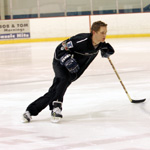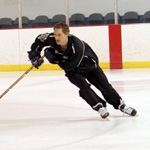2016/7/25 8:54:43
For 27 years I have been battling hockey people who maintain, Two Hands on the Stick, Two Hands on the Stick. The battle still looms large, because too many coaches still teach players to keep two hands on the stick at all times.
Wrong! For one thing, the stick belongs on the ice, where the puck is. Secondly, by keeping both hands on the stick, players are forced to swing the stick high in the air, and from side to side (pitching hay) when skating fast.
A famous player once said to me, "Anyone who skates with their stick in the air is playing for the other team." How true! How many times have I seen NHL players lose an opportunity to catch a puck on their stick because they could not get the stick on the ice quickly enough? Far too many!

Another player once said to me, "If I am skating down the ice, looking to pass to my team mate, and he has his stick in the air, no way am I going to pass to him. He's not giving me a target!" Also true!
I maintain that when players have an opportunity for a breakaway, or when they are skating in open ice, attempting to accelerate, or when they do not have the puck, they should skate with one hand on the stick and use their arms forward and backward in the same motion and in rhythm with their legs. This method helps increase their forward momentum.

The other problem with keeping two hands on the stick at all times is that when a player goes into a check with both hands on the stick, it encourages cross checking, high sticking, boarding, or other inappropriate (and often ugly) penalties. Keeping the stick in the top hand encourages legal shoulder checks. At the time of contact, the player can (and should) put the second hand on the stick in order to get the puck.
Once habits are instilled, they can be fine tuned and modified for specific situations. Poor hockey habits, like all other habits, are hard to break. So learn good habits! Learn when to carry the stick in one hand, and when to carry it in two hands. Learn to anticipate game situations and be able to modify your play according to the needs of those situations.
Remember - There is never just one way to do anything
Many of you know that we are supposed to start on out toes. But do you know why? And do you know whe
Technique Training – How Much is Enough?
Through the years I have noticed that only a relatively small percentage of players enroll in power
There are skills … and there are SKILLS in the heat of battleThis tip was written by Jack Blatherwic
Contact management E-mail : [email protected]
Copyright © 2005-2016 Outdoor sports All Rights Reserved